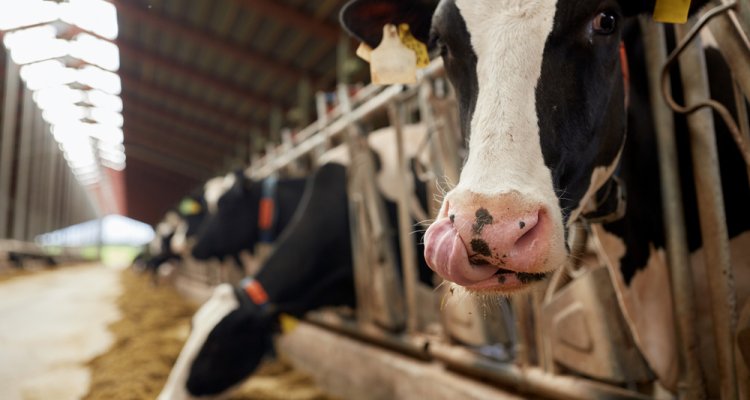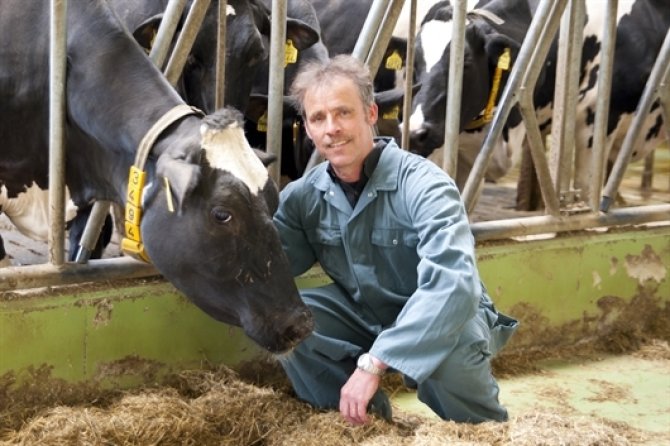
Showcase
Changing the cow’s diet reduces methane and nitrogen emissions
Many people love milk, but dairy cows emit methane and nitrogen during its production. The greenhouse gas methane contributes to global warming, while nitrogen is deposited in natural areas in the form of ammonia and is bad for biodiversity. Changing the composition of animal feed can help to solve this.
The standard diet of dairy cows includes roughage such as grass, grass silage, hay and maize silage, and concentrated feed consisting of potato fibre and maize meal, for example. The farmer regulates the amount of protein and other nutrients the cows receive with concentrated feed to keep them healthy and productive, but eating roughage and concentrated feed produces the greenhouse gas methane. “In the cow’s rumen, a community of billions of microorganisms converts fibrous feed into nutrients such as volatile fatty acids,” says cattle nutrition expert Jan Dijkstra. “The greenhouse gas methane is released by this process and breathed into the air by the cow.”
The feed that cows eat and digest also causes nitrogen emissions. “Farmers often give their cows feed that is about 10 per cent too rich in nitrogen-containing protein. This nitrogen ends up in the urine and partly evaporates as ammonia, which is deposited in the environment. The soil becomes nitrogen-enriched and acidifies, which is bad for biodiversity,” explains Dijkstra. “The dairy farming industry is responsible for some 35 per cent of all nitrogen deposition from Dutch sources. 160 nature areas in the Netherlands have been designated protected areas,but the maximum allowable nitrogen deposition is exceeded by a wide margin in about 120 of these areas. This restricts all manner of other activities, such as housing construction, that also release nitrogen.”

Changing stockfeed
According to Dijkstra, we need to consider the dairy cow’s diet.The Animal Nutrition chair group and Feed for Future are analysing what happens when you reduce the protein content of the diet. “We measure how much nitrogen enters the animal through its feed and how much is released in the milk, manure and urine it produces. After all, nitrogen that doesn’t go in won’t come out. We can feed the cow about 10 per cent less protein without it having a negative effect on milk production and the cow’s health. We can do this, for example, by reducing the protein in concentrates and feeding more maize silage. This results in about 15 per cent less ammonia, which can help farmers to meet the emission standards. At the same time leeway is created for the ammonia emissions of housing construction and other activities.”
Young grass on the menu
Roughage plays a prominent role in the diet compiled by the researchers. They measure feed intake, milk production and – using advanced sensors – the methane production of dairy cows in special respiration chambers in Wageningen. “We have discovered that it is better to feed cows grass silage made from shorter, leafier grass than grass mown at a later stage of growth. If you harvest grass for silage later, it will be stiffer and less easily digestible. Eating young grass or young grass silage results in up to 30 per cent less methane emissions. However, young grass does contain a lot of nitrogen, so it is important to reduce the nitrogen content in the rest of the cows’ diet if you feed them this leafy and easily digestible grass silage.”
Relationship between grass quality and methane emissions
Before now, there was little understanding worldwide of the relationship between grass quality and methane emissions by cows. “Researchers around the world can now build on our research results. It is our contribution to the fight against global warming, while the government and farmers in the Netherlands can also use our results to find their way out of the nitrogen crisis.”
Maize silage
There is one way to change the menu of cows that will reduce methane as well as ammonia. Dijkstra: “Maize silage is low in protein. It provides starch which partially bypasses the rumen (so there is less methane production) and is converted in the small intestine into glucose, so energy for the cow. This process improves the utilisation of nitrogen in the cow and so less nitrogen ends up in the urine.”